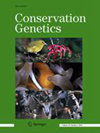Conservation Genetics promotes the conservation of genetic diversity by providing a forum where data and ideas can be presented facilitating the further development of this field of study. Contributions come from researchers in a variety of fields including population genetics molecular ecology and biology evolutionary biology and systematics to name just a few. Conservation issues are multifaceted and incorporate diverse disciplines. This journal will focus on genetic and evolutionary applications to the problems of conservation while reflecting the diversity of concerns that are relevant to conservation biology. Papers are accepted in the following categories: full research papers review papers short communications and short methodological notes (including lab methods computer programs & models and PCR primers). Topics may include but are not restricted to: The taxonomic identification and phylogenetic classification of species and populations and measures of phylogenetic diversity and uniqueness. The identification of hybrid species hybridization in native populations and assessing the history and extent of introgression between species. Population genetic structure of natural and managed populations including the identification of 'evolutionary significant units' and 'management units' for conservation and integration with studies in large-scale ecology (e.g. using GIS and related technologies). The assessment of levels of genetic variation within a species or population including small or endangered populations and the estimation of measures such as effective population size (e.g. through the application of coalescence models to estimate demographic variables). Studies on the impact of inbreeding and outbreeding depression and on the relationship between heterozygosity and measures of fitness. Assessments of mate choice and reproductive strategy (e.g. when the natural pattern of behaviour is thought to have been disrupted). Forensic applications especially for the control of trade in endangered species Practical methods for maximising genetic diversity during captive breeding programs and re-introduction schemes including mathematical models and case studies. Conservation issues related to the introduction of GM plants and animals. The direct interaction between environmental contaminants and the biology and health of an organism. This could include studies on the effect of anthropogenic factors on mutation rates evolutionary adaptation to local changes in the environment (such as industrial melanism) and studies on specific genetic systems that are affected by changes in the environment (such as evidence for the immunosuppresive effects of some contaminants or an impact on the frequency of specific MHC haplotypes).
